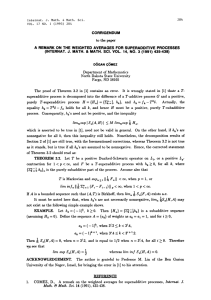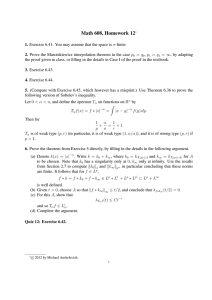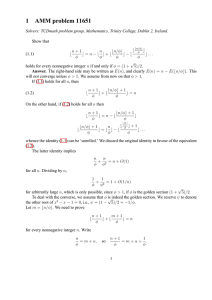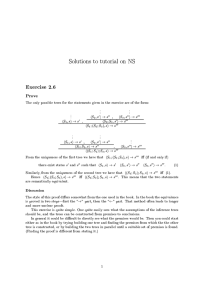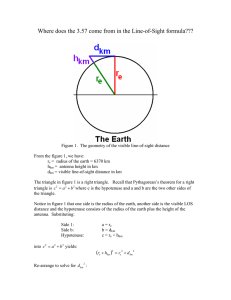GROWTH OF ENTIRE A -SUBHARMONIC FUNCTIONS Tero Kilpel¨
advertisement
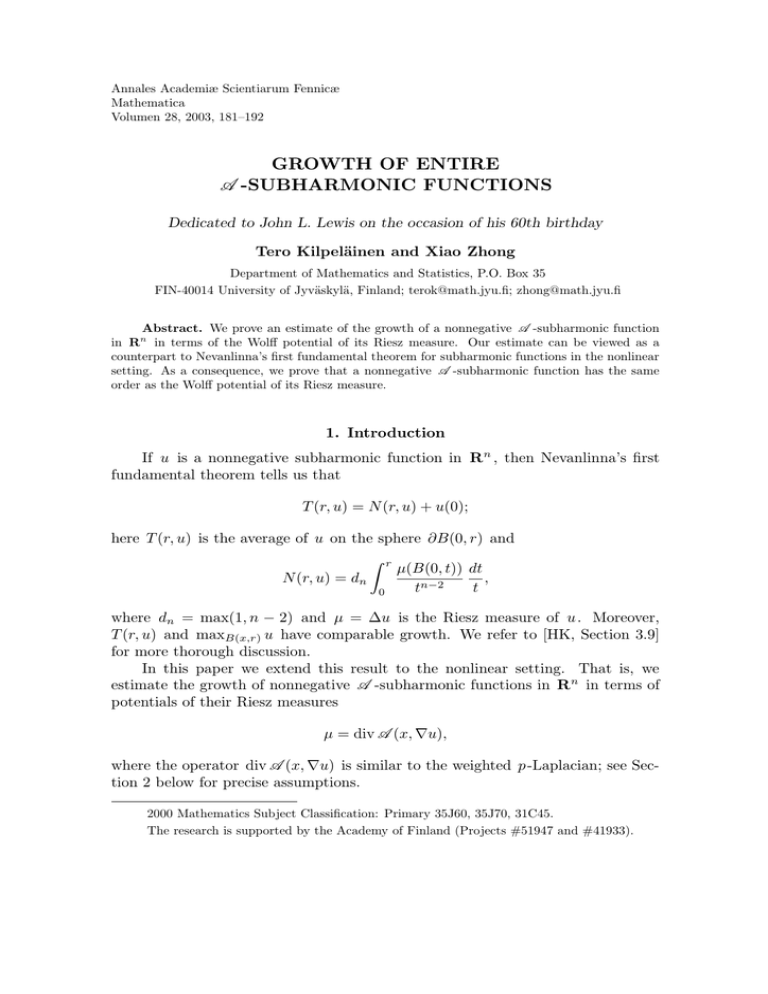
Annales Academiæ Scientiarum Fennicæ
Mathematica
Volumen 28, 2003, 181–192
GROWTH OF ENTIRE
A -SUBHARMONIC FUNCTIONS
Dedicated to John L. Lewis on the occasion of his 60th birthday
Tero Kilpeläinen and Xiao Zhong
Department of Mathematics and Statistics, P.O. Box 35
FIN-40014 University of Jyväskylä, Finland; terok@math.jyu.fi; zhong@math.jyu.fi
Abstract. We prove an estimate of the growth of a nonnegative A -subharmonic function
in Rn in terms of the Wolff potential of its Riesz measure. Our estimate can be viewed as a
counterpart to Nevanlinna’s first fundamental theorem for subharmonic functions in the nonlinear
setting. As a consequence, we prove that a nonnegative A -subharmonic function has the same
order as the Wolff potential of its Riesz measure.
1. Introduction
If u is a nonnegative subharmonic function in Rn , then Nevanlinna’s first
fundamental theorem tells us that
T (r, u) = N (r, u) + u(0);
here T (r, u) is the average of u on the sphere ∂B(0, r) and
Z r
µ(B(0, t)) dt
,
N (r, u) = dn
tn−2
t
0
where dn = max(1, n − 2) and µ = ∆u is the Riesz measure of u . Moreover,
T (r, u) and maxB(x,r) u have comparable growth. We refer to [HK, Section 3.9]
for more thorough discussion.
In this paper we extend this result to the nonlinear setting. That is, we
estimate the growth of nonnegative A -subharmonic functions in R n in terms of
potentials of their Riesz measures
µ = div A (x, ∇u),
where the operator div A (x, ∇u) is similar to the weighted p -Laplacian; see Section 2 below for precise assumptions.
2000 Mathematics Subject Classification: Primary 35J60, 35J70, 31C45.
The research is supported by the Academy of Finland (Projects #51947 and #41933).
182
Tero Kilpeläinen and Xiao Zhong
Our first result gives a double-sided estimate on the maximal growth of a
nonnegative A -subharmonic function u in terms of the (weighted) Wolff potential
of its Riesz measure µ ,
¡
¢ ¶1/(p−1)
Z rµ
dt
µ
p µ ¡B(x, t) ¢
(1.1)
Wp,w (x, r) =
t
.
t
w B(x, t)
0
In the unweighted case, where w is Lebesgue measure, the Wolff potential takes
the form
¢ ¶1/(p−1)
Z rµ ¡
µ
B(x,
t)
dt
µ
(x, r) = const
,
Wp,1
n−p
t
t
0
which with an appropriate choice of the constant reduces to N (r, u) , if p = 2 .
1.2. Theorem. Let u be a nonnegative A -subharmonic function in Rn and
µ = div A (x, ∇u) its Riesz measure. Then there is a constant δ = δ(n, p, λ, Λ, c w )
≥ 1 such that for all r > 0
¡ 1 ¢
µ
µ
(0, δr)
u(0) + c1 Wp,w
0, 2 r ≤ M (r) ≤ 2u(0) + c2 Wp,w
where
M (r) = sup u
B(0,r)
and c1 , c2 are positive constants depending only on n , p , λ , Λ and constants
associated with weight w .
Observe that by the maximum principle
M (r) = sup u = max u.
B(0,r)
∂B(0,r)
The proof of Theorem 1.2 is based on the pointwise potential estimate for the A superharmonic functions [KM2] and on a method by Eremenko and Lewis [EL].
1.3. Corollary. Let u be a nonnegative A -subharmonic function in Rn
and µ its Riesz measure. Then u is bounded in Rn if and only if
µ
Wp,w
(0, ∞) < ∞.
As in [HK, Definition 4.1], we define the order ν̄ and the lower order ν of a
positive increasing function S(r) by
log S(r)
,
r→∞ log r
ν̄ = lim
log S(r)
.
r→∞ log r
ν = lim
If u is a nonnegative A -subharmonic function in Rn , unbounded above, we define
the order and the lower order of u be the same as that of M (r) = supB(0,r) u .
Growth of entire A -subharmonic functions
183
1.4. Corollary. Let u be a nonnegative A -subharmonic function in Rn and
µ
(0, r) coincide.
µ its Riesz measure. Then the order of u and the order of Wp,w
The same holds for lower orders.
Corollaries 1.3 and 1.4 generalize classical results for the Laplacian [HK, Theorem 3.20 and 4.4]. Our results seem to be new even for linear uniformly elliptic
equations in divergence form.
2. Preliminaries
In this section, we recall necessary definitions and required preliminary results.
We shall work in a weighted setup. A function w ∈ L1loc (Rn ) , w > 0 a.e., is
called a weight; also the associated measure is denoted by w , that is,
Z
w(E) =
w dx
E
for all measurable E ⊂ Rn . In what follows we shall always assume that w is
p -admissible in the sense of [HKM], i.e. the following four properties hold:
I Doubling: there is a constant CI ≥ 1 such that
¡
¢
¡
¢
w B(x, 2r) ≤ CI w B(x, r)
for all balls B(x, r) ⊂ Rn .
II Uniqueness of the gradient: If Ω is an open set in Rn and (ϕj ) ⊂ C ∞ (Ω)
is a sequence of functions such that as j → ∞ ,
Z
Z
p
|ϕj | dw → 0 and
|∇ϕj − v|p dw → 0,
Ω
Ω
where v ∈ Lp (Ω; w) , then v = 0 a.e. in Ω .
III Sobolev inequality: There are constants κ > 1 and CIII > 0 such that
µ
1
w(B)
Z
B
|ϕ|
κp
dw
¶1/κp
µ
1
≤ CIII r
w(B)
Z
B
p
|∇ϕ| dw
¶1/p
for all balls B = B(x, r) ⊂ Rn and for all ϕ ∈ C0∞ (B) .
IV Poincaré inequality: There is a constant CIV > 0 such that
Z
Z
p
p
|∇ϕ|p dw
|ϕ − ϕB | dw ≤ CIV r
B
B
for all balls B = B(x, r) ⊂ Rn and for all bounded ϕ ∈ C ∞ (B) , where
Z
1
ϕB =
ϕ dw.
w(B) B
184
Tero Kilpeläinen and Xiao Zhong
In what follows we shall indicate the dependence on the above constants C I , κ ,
CIII , and CIV by cw .
The above properties of the weight form a sufficient framework for a theory
of quasilinear PDEs. This was first proven by Fabes, Kenig, and Serapioni in
[FKS] and further exploited in [HKM]. Nowadays it is known that the uniqueness
of the gradient and the Sobolev inequality can be deduced from the other two
properties; the first was proven by Semmes (see [HeK]) and the second can be
found e.g. in [HaK].
Examples of p -admissible weights are the constant weight w = 1 , Muckenhoupt’s Ap -weights, and certain powers of the Jacobians of quasiconformal mappings [HKM, Chapter 15].
Throughout, we let 1 < p < ∞ be a fixed number and Ω an open set in Rn .
The weighted Sobolev space H 1,p (Ω; w) is the completion of the set
with respect to the norm
©
kϕk1,p,w =
ϕ ∈ C ∞ (Ω) : kϕk1,p,w < ∞
µZ
p
Ω
|ϕ| dw
¶1/p
+
µZ
ª
p
Ω
|∇ϕ| dw
¶1/p
,
1,p
(Ω; w) the corresponding local space. The closure of C0∞ (Ω) in
and Hloc
H 1,p (Ω; w) is denoted by H01,p (Ω; w) . For the basic properties of weighted Sobolev
spaces we refer to [HKM, Chapter 1].
A -subharmonic functions. We assume that A : Rn × Rn → Rn is a
mapping satisfying the following properties:
(2.1)
the mapping x 7→ A (x, ξ) is measurable for all ξ ∈ Rn , and
the mapping ξ 7→ A (x, ξ) is continuous for a.e. x ∈ Rn .
There are constants 0 < λ ≤ Λ ≤ ∞ such that for a.e. x ∈ Rn and for all ξ ∈ Rn
|A (x, ξ)| ≤ Λw(x)|ξ|p−1 ,
(2.2)
(2.3)
¡
¢
A (x, ξ) − A (x, ζ) · (ξ − ζ) ≥ λw(x)(|ξ| + |ζ|)p−2 |ξ − ζ|2 ,
whenever ξ, ζ ∈ Rn , and
(2.4)
A (x, tξ) = t|t|p−2 A (x, ξ)
Growth of entire A -subharmonic functions
185
for all t ∈ R \ {0} . A basic example of A satisfying the assumptions (2.1)–(2.4) is
the weighted p -Laplacian, A (x, ξ) = w(x)|ξ|p−2 ξ ; in the unweighted case, where
w = 1 this reduces to the p -Laplacian and, further, to the classical Laplacian if
p = 2.
The above properties enable us to define a differential operator as follows.
p−1
Assume that v is a measurable function such that
¡ |v| ¢ is locally integrable
in Ω with respect to w -measure. Then − div A x, v(x) can be defined in the
distributional sense:
Z
¡
¢
− div A (x, v)(ϕ) =
A x, v(x) · ∇ϕ dx,
ϕ ∈ C0∞ (Ω).
Ω
1,p
The continuous function u ∈ Hloc
(Ω; w) is called A -harmonic in Ω , if
−div A (x, ∇u) = 0
in Ω.
A -subharmonic functions are defined via the comparison principle: an upper
semicontinuous function u: Ω → R ∪ {−∞} is A -subharmonic in Ω if it is not
identically −∞ and if for all open D b Ω and h ∈ C(D ) , A -harmonic in D ,
the condition h ≥ u on ∂D implies h ≥ u in D . Further, a function v is
A -superharmonic in Ω if −v is A -subharmonic in Ω .
It is well known that in the case of the Laplacian, i.e. A (x, ξ) = ξ , this
definition is one of the equivalent characterizations of subharmonic functions, often
defined via a submean value property, see [HK]. For a thorough discussion of A subharmonic functions see [HKM].
Truncations of A -subharmonic functions belong locally to the Sobolev space
1,p
Hloc (Ω; w) which leads to the definition of the weak gradient
Du = lim ∇ max(u, −k).
k→∞
This weak gradient is measurable and |Du|p−1 is locally w -integrable. Hence the
operator div A (x, Du) is well defined. It can be shown that it is a nonnegative
distribution whence represented by a Radon measure µ . We call this Radon
measure
µ = div A (x, Du)
the Riesz measure of an A -subharmonic function u . For these properties the
reader is referred to [HKM, Chapter 7], [KM1], and [M].
A fundamental property of A -harmonic functions is the Harnack inequality.
2.5. Harnack’s inequality. Let h be a nonnegative A -harmonic function
in B(x0 , r) . Then
sup h ≤ c(1 − τ )−β inf h,
B(x0 ,τ r)
B(x0 ,τ r)
where c = c(n, p, λ, Λ, cw ) and β = β(n, p, λ, Λ, cw ) are positive constants.
186
Tero Kilpeläinen and Xiao Zhong
We refer to [HKM, 6.2] for a proof of (2.5) when τ = 12 . The general case
follows by iteration.
For the proof of Theorem 1.2 we need the following pointwise estimate for A superharmonic functions established in [KM2]; see also [M, Theorem 3.1] and [MZ].
2.6. Theorem. Let u be a nonnegative A -superharmonic function in
B(x0 , r) and
µ = −div A (x, ∇u).
Then
¢
¡
µ
c3 Wp,w
x0 , 21 r ≤ u(x0 ) ≤ c4
inf
B(x0 ,r/2)
µ
u + c5 Wp,w
(x0 , r),
where c3 , c4 and c5 are positive constants depending only on n , p , λ , Λ , and
µ
cw , and Wp,w
(x0 , r) is the Wolff potential of µ , defined as in (1.1) .
3. Proof of Theorem 1.2
For the proof of Theorem 1.2, we need the following lemma, whose proof is
similar to that of [EL, Lemma 1].
3.1. Lemma. Let u be a nonnegative A -subharmonic function in Rn and
µ its Riesz measure. Then there is θ = θ(n, p, λ, Λ, cw ) , 0 < θ < 1 , such that if
M (tr) ≤ θM (r) for some 0 < t ≤ 1 and r > 0 , then
¡
¢ ¶1/(p−1)
µ
p µ ¡B(0, 2r) ¢
,
M (r) ≤ c6 r
w B(0, 2r)
where c6 = c6 (t, n, p, λ, Λ, cw ) > 0 , and M (r) is defined as in Theorem 1.2.
Proof. We treat two cases: p ≥ 2 and 1 < p < 2 separately. First suppose
that p ≥ 2 . Let h be the A -harmonic function in B(0, 2r) with boundary value
u , that is,
½
−div A (x, ∇h)
¡ = 0 in B(0,
¢ 2r),
(3.2)
h − u ∈ H01,p B(0, 2r); w .
The existence of h follows from the theory of monotone coercive operators, see
1,p
[HKM, Corollary 17.3]. We note that u ∈ Hloc
(Rn ; w) , since u is A -subharmonic
in Rn and bounded from below [HKM, Corollary 7.20]. By the comparison principle [HKM, 3.18], 0 ≤ u ≤ h in B(0, 2r) . From the Harnack inequality 2.5, we
have
inf h ≥ c7 sup h ≥ c7 sup u = c7 M (r),
B(0,r)
B(0,r)
B(0,r)
where c7 = c7 (n, p, λ, Λ, cw ) ≤ 1 . Thus, for all x ∈ B(0, tr) ,
(3.3)
h(x) − u(x) ≥ inf h − sup u ≥ c7 M (r) − θM (r) ≥ 12 c7 M (r),
B(0,r)
B(0,tr)
Growth of entire A -subharmonic functions
187
by the assumption M (tr) ≤ θM (r) and choosing θ = 12 c7 . The function
¡
¢
ϕ = min h − u, 21 c7 M (r)
B(0,2r)
¡
¢
is nonnegative in B(0, 2r) and belongs to H01,p B(0, 2r); w . By (3.3),
ϕ = 21 c7 M (r)
(3.4)
on B(0, tr).
Let L be the set of points where ∇ϕ exists and is nonzero. Using ϕ as a testfunction in the equations of u and h , we deduce that
Z
Z
p
λ
|∇ϕ| dw ≤ λ (|∇h| + |∇u|)p−2 |∇h − ∇u|2 dw
B(0,2r)
L
Z
¡
¢
A (x, ∇h) − A (x, ∇u) · ∇ϕ dx
≤
B(0,2r)
(3.5)
Z
Z
=−
A (x, ∇u) · ∇ϕ dx =
ϕ dµ
≤
B(0,2r)
¡
¢
1
c
M
(r)µ
B(0,
2r)
.
7
2
B(0,2r)
Here we employed the fact that p ≥ 2 and assumption (2.3). On the other hand,
by (3.4), Hölder’s inequality and the Sobolev inequality (III),
¢p ¡
¢
2 c7 M (r) w B(0, tr) ≤
¡1
(3.6)
Z
ϕp dw
B(0,2r)
¡
¢1−1/κ
≤ w B(0, 2r)
Z
p
p
≤ CIII (2r)
µZ
B(0,2r)
ϕ
B(0,2r)
κp
dw
¶1/κ
|∇ϕ|p dw.
We conclude the proof in this case by combining (3.5), (3.6) and
¡
¢
¡
¢
w B(0, 2r) ≤ c8 w B(0, tr) ,
(3.7)
where c8 = c8 (t, CI ) ≥ 1 , which easily follows from the doubling property I of w .
To prove the lemma for 1 < p < 2 , let H = H(
¡ · , s) be ¢the A -harmonic
function in B(0, s) , r < s < 2r , with H − u ∈ H01,p B(0, s); w . If r ≤ s0 < s ,
then from the Harnack’s inequality (2.5) we find as above that
inf H ≥ c(s, s0 ) sup H ≥ c(s, s0 )M (s0 ),
B(0,s0 )
B(0,s0 )
188
Tero Kilpeläinen and Xiao Zhong
where
µ
¶β
1 s − s0
,
c(s, s ) =
c
s
0
(3.8)
and c , β are constants in (2.5). Thus, for all x ∈ B(0, tr) ,
H(x, s) − u(x) ≥ inf 0 H − sup u ≥ c(s, s0 )M (s0 ) − θM (r) ≥ 21 c(s, s0 )M (s0 ),
B(0,s )
B(0,tr)
if we assume that
(3.9)
c(s, s0 )M (s0 ) ≥ 2θM (r).
Let
¢
¡
ϕ = min H − u, 12 c(s, s0 )M (s0 ) ,
B(0,s)
and L be the set of points in B(0, s) where ∇ϕ exists and is nonzero. We note
that
ϕ = 21 c(s, s0 )M (s0 )
on B(0, tr).
Using ϕ as a test-function in the equations of H and u , we deduce as in (3.5)
that
Z
I1 = λ (|∇H| + |∇u|)p−2 |∇H − ∇u|2 dw
(3.10)
L
¡
¢
¡
¢
1
≤ 2 c(s, s0 )M (s0 )µ B(0, s) ≤ 21 c(s, s0 )M (s0 )µ B(0, 2r) .
By Hölder’s inequality, we have
(3.11)
Z
µZ
p
B(0,s)
|∇ϕ| dw ≤
×
Let
I2 =
Z
L
(|∇H| + |∇u|)
µZ
B(0,s)
p−2
2
|∇H − ∇u| dw
p
B(0,s)
(|∇H| + |∇u|) dw
¶(2−p)/2
¶p/2
.
(|∇H| + |∇u|)p dw.
We estimate I2 as follows. First, by the quasiminimizing property of A -harmonic
functions [HKM, 3.15]
Z
µ ¶p Z
Λ
|∇u|p dw.
|∇H| dw ≤
λ
B(0,s)
B(0,s)
p
Growth of entire A -subharmonic functions
189
Secondly, by the well-known Caccioppoli inequality (see [HKM, 3.27]), we have for
s < s00 ≤ 2r
µ ¶p
Z
Z
Λ
(4p)p
p
|∇u| dw ≤
|u|p dw
00 − s)p
λ
(s
00
B(0,s)
B(0,s )
µ ¶p
p
¡
¢
(4p)
Λ
w
B(0,
2r)
M (s00 )p .
≤
λ (s00 − s)p
These together lead us to the estimate
I2 ≤
(3.12)
(s00
¡
¢
c
w B(0, 2r) M (s00 )p ,
p
− s)
where c = c(p, λ, Λ) > 0 . Combining (3.10)–(3.12), we obtain that
Z
¡
¢¢p/2
¡
|∇ϕ|p dw ≤ c(s00 − s)−p(2−p)/2 12 c(s, s0 )M (s0 )µ B(0, 2r)
B(0,s)
(3.13)
¡
¢(2−p)/2
× w B(0, 2r)
M (s00 )p(2−p)/2 .
On the other hand, as in (3.6) and (3.7), we deduce that
1
c8
µ
c(s, s0 )
M (s0 )
2
¶p
¡
¢
w B(0, 2r) ≤
p
CIII
sp
Z
B(0,s)
|∇ϕ|p dw,
which, together with (3.13), gives
(3.14)
M (s0 )p/2 ≤ csp c(s, s0 )−p/2 (s00 − s)−p(2−p)/2
¡
¢−p/2 ¡
¢p/2
× w B(0, 2r)
µ B(0, 2r)
M (s00 )p(2−p)/2 ,
where c = c(t, p, λ, Λ, cw ) > 0 . This can be rewritten, after some juggling, as
(3.15)
where
(3.16)
and
¡
¢2−p
Ψ(s0 ) ≤ k(s, s0 , s00 ) Ψ(s00 )
,
Ψ(τ ) = M (τ )
p/2
µ
¶−p/2(p−1)
p µ(B(0, 2r))
r
w(B(0, 2r))
k(s, s0 , s00 ) = csp c(s, s0 )−p/2 (s00 − s)−p(2−p)/2 r−p
2
/2
.
Estimate (3.15) holds for all r ≤ s0 < s < s00 ≤ 2r if (3.9) is satisfied.
190
Tero Kilpeläinen and Xiao Zhong
Now, let
sj = 2r(1 − 2−j ),
j = 1, 2, . . . ,
and put s0 = sj , s00 = sj+1 and s = 12 (sj + sj+1 ) . We note that (3.9) is always
true for j = 1 , that is, (3.9) is true for s0 = s1 , s = 12 (s1 + s2 ) , if we choose
θ = 21 c
¡1
¢
(s
+
s
),
s
=
1
2
1
2
1
.
2c 5β
Let θ be chosen in this way. We prove that the lemma is true for such a θ . Now
we have two possibilities:
(i) (3.9) is true for all j = 1, 2, . . . . Then in this case M (r) = 0 , which easily
follows from (3.9) and the fact M (2r) < ∞ . The lemma is trivial.
(ii) (3.9) is not true for some j . Let j0 be the smallest number for which
it fails. Then j0 > 1 , since (3.9) is satisfied for j = 1 by our choice of θ . This
means (3.9) is true for all j = 1, 2, . . . , j0 − 1 , but
¡
¢
(3.17)
c 21 (sj0 + sj0 +1 ), sj0 M (sj0 ) < 2θM (r).
Consequently (3.15) is true for s0 = sj , s00 = sj+1 and s = 12 (sj + sj+1 ) for all
j = 1, 2, . . . , j0 − 1 , and
k(s, s0 , s00 ) ≤ c 2γj
for some γ = γ(n, p, λ, Λ, cw ) ≥ 1 . Using this inequality in (3.15) and iterating we
obtain
(3.18)
Ψ(s1 ) ≤ c 2γ Ψ(s2 )2−p ≤ · · · ≤ (c 2γ )β Ψ(sj0 )(2−p)
where
β=
∞
X
j=1
j0 −1
,
j(2 − p)j−1 < ∞.
Taking account of the fact that 1 < p < 2 , we deduce from (3.17) and (3.18) by
an easy calculation that
Ψ(s1 ) ≤ c,
where c > 0 depends only on t , n , p , λ , Λ , cw , not on j0 . This concludes the
proof of the lemma.
Now we are ready to give the proof of Theorem 1.2.
Proof of Theorem 1.2. We first prove the left-hand inequality in Theorem 1.2.
Let u be a nonnegative A -subharmonic function in Rn and µ its Riesz measure.
Since v = M (r) − u is a nonnegative A -superharmonic function in B(0, r) and
−div A (x, ∇v) = µ.
Growth of entire A -subharmonic functions
191
The left-hand inequality in Theorem 2.6 gives
¡ 1 ¢
µ
c3 Wp,w
0, 2 r ≤ M (r) − u(0),
which proves the left-hand inequality in Theorem 1.2.
Next, we prove the right-hand inequality in Theorem 1.2. Let
α=
2c4 − 1
< 1,
2c4
where c4 is the constant in Theorem 2.6. Let k be the integer such that αk <
θ ≤ αk−1 , where θ is the constant in Lemma 3.1, and let t = 2−k . Now fix r > 0 .
Suppose that there is j , 1 ≤ j ≤ k , such that
M (2−j r) ≥ αM (2−j+1 r).
Since M (2−j+1 r) − u is a nonnegative p -superharmonic function in B(0, 2−j+1 r) ,
Theorem 2.6 shows that
¡
¢
µ
M (2−j+1 r) − u(0) ≤ c4 M (2−j+1 r) − M (2−j r) + c5 Wp,w
(0, 2−j+1 r)
µ
≤ c4 (1 − α)M (2−j+1 r) + c5 Wp,w
(0, r)
µ
(0, r),
= 21 M (2−j+1 r) + c5 Wp,w
that is,
(3.19)
µ
(0, r).
M (tr) ≤ M (2−j+1 r) ≤ 2u(0) + 2 c5 Wp,w
If for all j = 1, 2, . . . , k ,
M (2−j r) < αM (2−j+1 r),
then
M (tr) = M (2−k r) < αk M (r) < θM (r).
We may now apply Lemma 3.1 to obtain that
¡
¢ ¶1/(p−1)
µ
µ
B(0,
2r)
¢
M (tr) ≤ M (r) ≤ c6 rp ¡
w B(0, 2r)
(3.20)
µ
≤ cWp,w
(0, 4r),
by the doubling property I of w . Since either (3.19) or (3.20) is true, we arrive at
µ
M (tr) ≤ 2u(0) + cWp,w
(0, 4r)
for all r > 0 . This is equivalent to the right-hand inequality of Theorem 1.2.
192
Tero Kilpeläinen and Xiao Zhong
References
[EL]
Eremenko, A., and J.L. Lewis: Uniform limits of certain A -harmonic functions with
applications to quasiregular mappings. - Ann. Acad. Sci. Fenn. Ser. A I Math. 16,
1991, 361–375.
[FKS] Fabes, E.B., C.E. Kenig, and R.P. Serapioni: The local regularity of solutions of
degenerate elliptic equations. - Comm. Partial Differential Equations 7, 1982, 77–
116.
[Hak] HajÃlasz, P., and P. Koskela: Sobolev meets Poincaré. - C. R. Acad. Sci. Paris Sér. I
Math. 320, 1995, 1211–1215.
[HK]
Hayman, W.K., and P.B. Kennedy: Subharmonic Functions, Vol. 1. - London Math.
Soc. Monogr. 9, Academic Press, London, 1976.
[HeK] Heinonen, J., and P. Koskela: Weighted Sobolev and Poincaré inequalities and quasiregular mappings of polynomial type. - Math. Scand. 77, 1995, 251–271.
[HKM] Heinonen, J., T. Kilpeläinen, and O. Martio: Nonlinear Potential Theory of Degenerate Elliptic Equations. - Oxford University Press, Oxford, 1993.
[KM1] Kilpeläinen, T., and J. Malý: Degenerate elliptic equations with measure data and
nonlinear potentials. - Ann. Scuola Norm. Sup. Pisa Cl. Sci. (4) 19, 1992, 591–613.
[KM2] Kilpeläinen, T., and J. Malý: The Wiener test and potential estimates for quasilinear
elliptic equations. - Acta Math. 172, 1994, 137–161.
[MZ]
Malý, K., and W.P. Ziemer: Fine Regularity of Solutions of Elliptic Partial Differential
Equations. - Math. Surveys Monogr. 51, American Mathematical Society, Providence,
RI, 1997.
[M]
Mikkonen, P.: On the Wolff potential and quasilinear elliptic equations involving measures. - Ann. Acad. Sci. Fenn. Ser AI Math. Dissertationes 104, 1996, 1–71.
Received 6 June 2002

